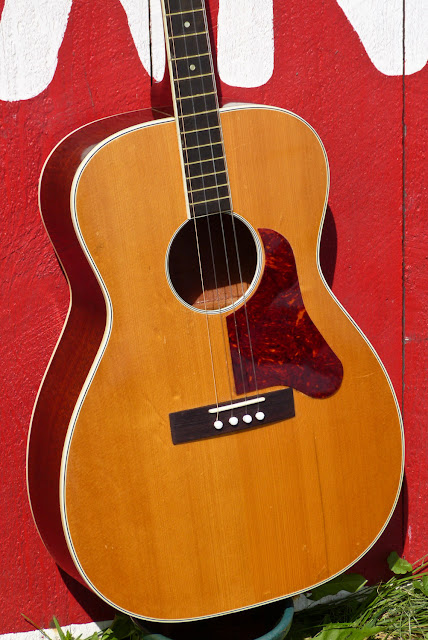1960s Harmony H1201T Tenor Guitar (Uke-Strung)
The owner of this tenor guitar is as idiosyncratic as the rest of us and is also a lefty aside from having his own stringing and tuning! Said tuning is uke-style GCEA with the lowest string in the same range as guitar's G and the E the same pitch as a guitar's high E. The A is then re-entrant a full step above the initial G. The catch here is that for the GC&E strings he uses plain nylon and for the A a wound steel string. Yikes! He was rocking a 20w or similar for the A but I swapped it to an 18w after setup.
This was in for work to get it up to snuff as its original bridge had split (pretty common for these dyed-maple Harmony bridges). My new custom one is rosewood, has an uncompensated saddle slot, and fits the bridge pins a little farther aft. Because Harmony installed their original bridge in the wrong place, I also had to install mine so the saddle would be a little more forward, too.
Aside from the bridge, I also cleated a top crack below the righty-thinking "treble" side of the bridge, knocked the neck angle back a hair, and leveled/dressed the frets.
For an idea of what a "stock" H1201T is like, check out my old blog post on a '63 version.
I can't find a date stamp inside, but the original plastic nut and general features suggest late '60s manufacture. I'd bet between '67 and '69.
While the board is bound, the board itself is "ebonized" maple like the original bridge was. The frets are also brass stock. This has a long, just-shy-of 23" scale length and a quick, C-shaped neck.
The righty pickguard is a replacement and I had to remove it and recut it a bit to fit with the bridge now in the right place.
I compensated the top of the new drop-in bone saddle to give better intonation for each string. Note the coming-up pickguard in this shot -- it's a self-stick style and I've since put it back down.














Comments